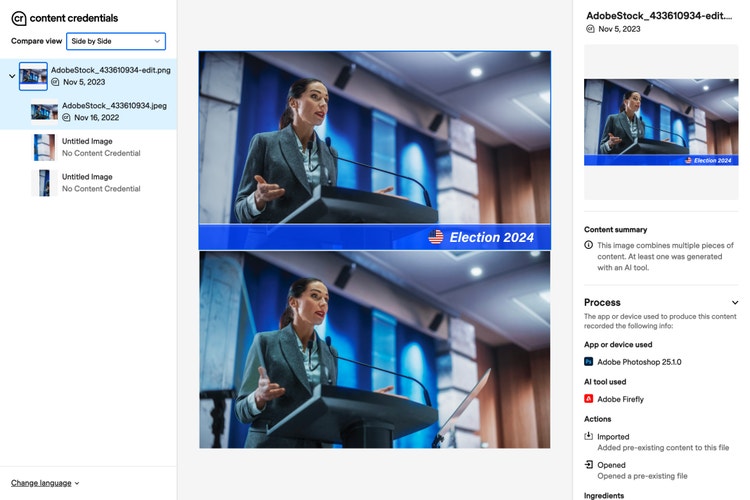Seizing the moment and driving adoption for Content Credentials in 2024

More than two billion voters are expected to participate in elections around the world in 2024. With a lion’s share of news and content consumption happening online today, the stakes have never been higher to ensure that people everywhere have access to transparency so that they can verify, and then trust the content they’re seeing online. As we embark on the new year, I’m excited to take a moment to reflect on a year of significant implementation and partnership momentum we’ve seen with Content Credentials across both the Content Authenticity Initiative (CAI) and the foundational open standards consortium the Coalition for Content Provenance and Authenticity (C2PA). Our ongoing collaboration with leaders across these communities points to a shared sense of urgency — a collective commitment to enhance trust in digital content, particularly in the generative era with Content Credentials — a “nutrition label” for digital content.
This past year, we experienced record momentum in attracting new members to the CAI, with our latest count surging past 2,000 members! Also a notable start to the year, OpenAI recently announced details around its initiatives to protect the integrity of global elections, including plans to implement Content Credentials for images generated by DALL·E 3. New and additional implementation of Content Credentials into generative AI platforms, camera hardware and mobile devices will be critical to broader access to provenance and transparency. We also remain committed to collaborating with social media companies, news organizations, policy makers and content creators across channels to make Content Credentials the industry gold-standard for establishing trust in the digital ecosystem. I expect to see more platforms, tools, and devices alike join our effort in 2024.
With the mature, open C2PA standard and CAI free, open-source tooling, Content Credentials now spans a swiftly growing range of platforms and technologies, including cameras, smartphones, software and more. Below examples shed light on Content Credentials momentum in the past year, including what we’ve achieved as part of the collective work from both the CAI and C2PA.
Adobe doubles down on Content Credentials in Firefly and Creative Cloud Applications
Adobe led continued innovation with creators in mind by driving implementation of Content Credentials across popular creative applications such as Adobe Photoshop and Adobe Lightroom — where creators can securely attach information such as name, date, edits made and tools used. This past year, Adobe announced additional Content Credentials availability for select generative AI features, including Generative Fill and text-to-image in Adobe’s generative AI model Firefly. Also in 2023, Content Credentials came to more Adobe Creative Cloud applications including Adobe Illustrator, Adobe Express, Adobe Stock and Behance.

Leica introduces world’s first camera with Content Credentials built-in
In October 2023, Leica introduced the world's first camera with Content Credentials built-in within the new Leica M11-P — revolutionizing the field of photojournalism by ensuring authenticity at the point of capture. As more photojournalists and creatives use this technology, consumers are going to start to see Content Credentials on more digital content — helping them better navigate the digital world.

Sony commits to implement Content Credentials into future camera models in 2024
Sony has committed to incorporating Content Credentials into its new Alpha 9 III line of cameras and Sony’s Alpha 1 and Alpha 7S III models via firmware updates. The company also collaborated with the Associated Press to conduct successful field-testing of this feature with photojournalists to provide authenticity throughout the news reporting process — from the point of capture through to editing and ultimately publishing.
Nikon plans to adopt Content Credentials into Camera models soon
Nikon has affirmed progress towards its commitment to bringing Content Credentials into upcoming camera models. With its vast set of consumer and professional customers worldwide, Nikon’s future implementation will help empower broad awareness and adoption. Nikon is now collaborating with international news agency, Agence France-Presse (AFP), to begin practical verification of this image provenance function — specifically to support authenticity and reliability in photojournalism and the fact-checking process.
Microsoft introduces Content Credentials to all AI-generated images created with Bing Image Creator
In Fall 2023, Microsoft introduced its use of Content Credentials to label all AI-generated images created with Bing Image Creator. Microsoft is also working to roll out Content Credentials capabilities in its graphic design application Microsoft Designer. More recently, Microsoft has also committed to helping candidates and campaigns maintain greater control over their content and likeness through its launch of Content Credentials as a service.
Qualcomm integrates Content Credentials at the chip level for next generation smartphones
Provenance technology will soon come to your smartphone with Content Credentials embedded at the chip level — supporting photo authenticity for consumers and their devices. In October 2023, Qualcomm announced its latest Snapdragon 8 Gen3 mobile platform that works with Truepic to support Content Credentials in camera systems, based on the global C2PA standard format.
BioBioChile starts implementing Content Credentials on its news site
BioBioChile, one of the most widely read news website in Chile, has taken a pioneering step by becoming the first news organization to begin integrating Content Credentials into its site. BioBioChile reporters now also have access to smart devices that will allow them to embed Content Credentials to their assets at the point of capture. This initiative is part of an ongoing plan to expand the implementation of Content Credentials across the entirety of the BioBioChile site in the future, demonstrating their commitment to enhancing trust in the digital ecosystem.
Closing thoughts
Since we first launched the CAI in 2019 and co-founded the C2PA in 2021, we’ve had a vision for a world in which creators and consumers come to expect Content Credentials so they can both show their work and discern whether or not to trust content they see online. I believe that world is closer than ever.
When we come together across technology, government, and civil society, listening to creators and information consumers, we bolster a basic right for everyone to understand how the content they consume was made. 2023 was the most vibrant year yet for the CAI, C2PA and Content Credentials, and we can’t wait to build on the momentum alongside our members and industry partners to ensure an even greater and lasting impact in 2024 and beyond.